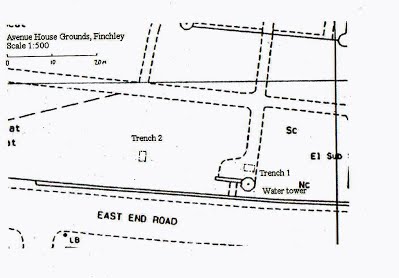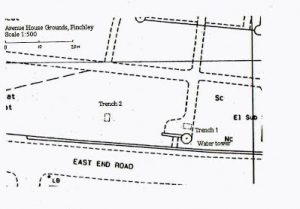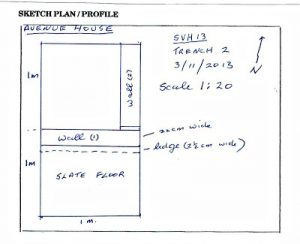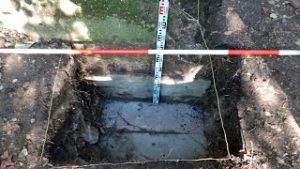
o. 514 January 2014 Edited by Sue Willetts
HADAS DIARY 2014
All Lectures are held at Avenue House, 17 East End Road, Finchley, N3 3QE, and start promptly at 8.00 pm, with coffee/tea and biscuits afterwards. Non-members welcome (£1.00). Buses 82, 125, 143, 326 & 460 pass nearby and Finchley Central Station (Northern line) is a short walk away.
Tuesday 14th January 2014, 8pm. The Naval Graveyards of Greenwich. Lecture by Malcolm Godfrey.
Tuesday 11th February 2014. To be confirmed.
Tuesday 11th March 2014, 8pm. The Sandridge Coin Hoard. Lecture by David Thorold, Curator (Prehistory to Medieval), Verulamium Museum.
Tuesday 8th April 2014, 8pm. Restoring House Mill (working title) Brian James-Strong, River Lea Tidal Mill Trust.
Further Dates for your diaries
The Mary Rose Museum. Thursday, 15th May 2014. If you would like to come please let us know in good time. We will travel by coach and spend the day at Portsmouth dock visiting the Mary Rose Museum, Nelson’s HMS. Victory and HMS Warrior. With an overall ticket for all the attractions and including the coach the cost is expected to be about £45 per person.
HADAS Long Outing to Kent 2014
This will be from Sunday June 29th to Thursday July 3rd, 2014, staying at a Best Western Hotel in Canterbury – Abbots Barton Hotel. Please see separate booking form.
Correction from December 2013 Newsletter: Don Cooper
It has been pointed out that in last month’s newsletter, in Judy Kazarnovsky’s obituary it said that HADAS had made a donation to the North London Hospice, it should have said that the donation was made by individuals as HADAS, a registered charity, cannot make donations to other charities. It was loose wording on my part – mea culpa. No HADAS funds were used.
HADAS Christmas Party
The third HADAS Christmas party was again held at Avenue House. These have proved to be some of the best attended events with around 50 members being present. It is good to see members who are unable to attend the lectures or outings coming along.
It was a similar format with a buffet lunch provided by Avenue House, then various activities consisting of a table quiz, raffle and musical entertainment. This year, besides communal singing, Jim and Jo performed a couple of Victorian numbers, with modified lyrics to encompass some of the HADAS characters.
It was an entertaining afternoon and all appeared to have had an enjoyable time. We look forward to seeing everybody in 2014 supporting more HADAS activities.
The following seasonal poem was mentioned by Liz Tucker to members of the Committee at the Christmas party. I hope you agree that it has a place in this first Newsletter of the year. Ed.
Deck the Halls Liz Tucker
Deck the halls with boughs of holly
Fala….
‘Tis the season to be jolly,
Trim the tree, put out the snacks,
Send the festive Yuletide fax.
Raise the roof, both male and female,
Send the jocund Yuletide e-mail,
With a message blithe and merry!
Mark it “Sent from my Black-Berry”.
Roast the goose, roll out the barrel,
From your iPod play a carol,
Singing of a mystic birth,
(Find the inn on Google Earth.)
Quaff the foaming mug of bitter,
Tweet your greetings round on Twitter,
Thinking, as the old year ends,
Of your numerous Facebook friends.
As the hours of darkness dwindle,
Read some Dickens on your Kindle,
Slice the pudding up, and next
Snd the mry Xms txt.
Celebrate, ye lads and lasses,
To the webcam raise your glasses.
Spread the word from pole to pole-
You needn’t meet a living soul!
Lions on Kunulua Talk by Fiona Haughey on November 12th Sue Willetts
This interesting and well illustrated talk was an excellent overview of the excavations and finds including fine sculptures from the Early Bronze and Iron Age periods at the ancient site of Tell Tayinat, in Hatay in south-eastern Turkey. This well positioned extensive site is situated to the north-east of Antioch on the bend of the Orontes River – originally a very fertile area which has become heavily silted up. The original excavations from the 1930’s were not fully published and re-excavation began in 1990. Fiona has been involved since 2003 mainly in drawing and recording work. More recently the proximity of the war zone to the east has made working conditions very difficult. Six areas are currently being worked on – the site is mainly composed of mud brick although some stone has been used but not for buildings. The team is concentrating on the citadel area and has identified a textile creation room, three palaces and a temple with stone steps leading to an important sacred precinct. A very important find of a large double sided cuneiform tablet contains details of a treaty which includes (and proves) the name of the city Kunulua.
As indicated by her title, Fiona decided to highlight some of the magnificent stone carvings from the site and showed us both photographs and her detailed drawings of the stone lions – they are definitely lions and not another cat species – from the distinctive tufts on the end of their tails. The craftsmen used basalt which would have been available locally. One was found lying on its side and when righted was found to be in perfect condition including finely carved genitalia. It would have had inlaid eyes and it is thought that the hollow area on the head was used to contain incense. Other ‘animal’ sculptures include a winged bull and a sphinx but the more recent and spectacular find is part of a colossal male figure with prominent eyes, a large nose, beard, curly hair, a necklace and a sword. The inscription of the back of his clothing identifies him as King Suppiluliuma.
Buxton Trip
Buxton itself Jim Nelhams
Our trips give us the chance to get to know other members and discover their different interests. So we had an afternoon to explore the town of Buxton. It’s so nice when exploring an unknown place to keep bumping into people you know, and stopping to exchange comments and ideas.
An Afternoon of Curiosity. Patrick McSharry
On our second full day our group had the opportunity of roaming Buxton at will delving into the cultural heritage and life of a market town which can reliably trace its origins back to the Roman period. Buxton enjoys the unique distinction of having the highest elevation (over 1000ft above sea level) of any market town in England. What is more, it is regarded as “the gateway” to the Peak District National Park.
The town of Buxton consists of an upper and lower town; the former being the old, and the latter the new part of the town and depending on one’s physical dexterity and level of curiosity determined how much time we were prepared to spend in making the most of our free afternoon in Buxton. Having visited Buxton twice in the past I chose simply to sample the culinary delights as well as visiting the book shops rather than overload my senses visiting, for example, the Buxton Museum or other cultural icons worthy of one’s attention and honed sense of awe.
Of greater significance perhaps for a town, as opposed to the big northern cities, Buxton has a vibrant cultural life on a par with the great urban centres such as Manchester and Leeds. Indeed it hosts several music and theatre festivals each year. This reputation has been further enhanced by the recent refurbishment of the Pavilion Arts Centre. The Opera House built in 1903 and designed by Frank Matcham who was also responsible for the design of two London theatres: the London Coliseum (1904) and the London Palladium (1910), has a year-long programme of drama, concerts, comedy and other cultural events. The International Gilbert & Sullivan Festival – a three-week long theatre festival – was hosted by Buxton from 1994 until this year. It is due to move to Harrogate for the 2014 due to Buxton’s failure, so it is reported, to commit to the festival’s future. This is a sad day for Buxton.
Buxton historical fame is that of a spa town because of the thermal springs which date back to the Roman occupation. That said, the thermal baths are, sadly, no longer open to the public (they finally closed in 1972) so ‘taking the waters’ is a thing of the past but this has not prevented Buxton continuing to refer to itself as a Spa town. After the First World War, the spa industry went into gradual decline and by the 1950s Buxton had become a ‘backwater’. However by the 1980s, like the phoenix rising from the ashes, Buxton had managed to reinvent itself into a developing cultural haven and more recently the University of Derby has opened a campus occupying the Devonshire Royal Hospital building which potentially may well rival (in the future) the great traditional seats of learning that we are so familiar with!
Architecturally Buxton has much to showcase. The Crescent was modelled on Bath’s Royal Crescent. Designed by John Carr it features a grand assembly room and boasts a fine painted ceiling. Currently it remains unoccupied although there are plans afoot for it to be converted into a hotel. A sign of the times perhaps! The Devonshire Dome which subsequently became the Devonshire Royal Hospital (and now the Devonshire Campus of the University of Derby) built, like the Crescent, in the latter part of the eighteenth century dominates Buxton’s skyline and helps to define its architectural history. It would be remiss of me if I did not mention as worthy of inspection Buxton railway station, the Pavilion Gardens, the Pump Room and the Palace Hotel which traditionally have defined the architectural tableau of Buxton. In terms of famous Buxtonians I ought to mention Vera Brittain (mother of Shirley Williams) of Testament of Youth fame. Elizabeth Spriggs the actress, Tim Brooke-Taylor (one of the Goodies) and Bruno Langley of Coronation Street fame to mention the few familiar names apropos the 20th century.
In being let loose in Buxton we all had our own agendas as to what we might do in terms of engaging our well honed senses in that cultural oasis that was Buxton itself set in a rural hinterland – heaven on earth. At the end of the day we were all very selective in our choices and once exhausted we beat a respectable retreat back to the hotel to enjoy the evening and the excellent fare which we had now come to expect of a reputable family hotel.
The Pavilion Gardens Railway Buxton David Robinson
Despite the inclement weather on the final morning in Buxton Emma and I decided to take another look at the substantial Victorian Pleasure Gardens at the centre of the town. In particular I wanted to make a further examination of the miniature railway and its locomotive and having got thoroughly wet I was not disappointed to locate what appeared to be a small steam locomotive in the railway’s tunnel which serves to protect locomotive and rolling stock when these are not in use. I was sufficiently interested to take a few measurements and it is apparent that the gauge is currently 12.25 inches (that tape measure often comes in handy), whilst the length of the track appeared to be in the region of 300 yards. Because of the weather we then made a quick retreat to the café in the Pavilion and left the gardens to the hundreds of ducks that had congregated there to celebrate their own version of a pleasant day. After this I did a little more research and, very much to my surprise, found that matters were not wholly as they seemed.
The gardens themselves can be dated to 1871 and were one of the parks laid out by Edward Milner. Looking at the formal arrangement of the flower beds, the carefully channelled river and the boating lake, together with the associated winter gardens and other buildings, it is easy to accept that the whole does indeed belong to the Victorian era. However, it appears that the railway was not constructed until 1972, when originally opened with a 10.25 inch gauge, and that it was not converted to the present gauge until 1998. In addition to this, although the locomotive has indeed been built to look as if it is steam operated, it is in fact a diesel hydraulic, undoubtedly easier to maintain and a more economic proposition (a sorry state of affairs for steam lovers). The current locomotive that was introduced with the change of gauge referred to is named after the designer of the gardens and operates at week-ends throughout the year. Previously the locomotive used was named Borough of Buxton and was of a similar design to the current motive power. Both of the locomotives were supplied by Shepperton Metal Products and Edward Milner appeared to be well maintained and was certainly a good deal drier than I was at the time of observation. The moral of this tale? Things are not always as they first appear.
Laundry – What Laundry? By Don Cooper
As briefly referred to in last month’s newsletter (no. 513 December 2013) HADAS have been excavating at Avenue House. The main objective of the dig was to examine the depression in the ground in front of the water tower. Bill Bass is currently writing this up for a future newsletter. However, there is a mention of a laundry being west of the water tower as well as some glasshouses in the Avenue House’s draft Conservation Management Plan 2013, so it was decided with Avenue House management’s agreement that we could put in a small trench (2m x 1m) called Trench 2 to see if we could get any evidence of these structures. The sketch (Fig. 1, see page 6) with East End Road at the bottom shows where the trench was in relation to the water tower.
Figure 1 Location of Trench 2
The trench was located over a protruding piece of west facing apparent wall. Although this was a very small trench it yielded quite a lot of intriguing information. After we had removed the leaves and litter detritus mainly sweet paper, we confirmed that the protruding structure was indeed the remains of a wall made of similar reinforced concrete to the water tower. As can be seen from the sketch in Figure 2 and the photograph labelled Figure 3.
Figure 2 – Sketch of Trench 2
Figure 2 Trench 2 with slate floor facing west
Other Societies’ Events
Wednesday 22nd Jan. 7.45 pm. Friern Barnet & District Local History Soc. North Middx. Golf Club, The Manor House, Friern Barnet Lane, N20 0NL. NB: New venue. Postcards of the Easter Rising. Talk by Edward Margiotta. Non members £2.00. Refreshments before and after the talk.
Tuesday 28th Jan. 6.00 pm. Gresham College, at Museum of London. 150 London Wall, EC2Y 5HN. Modern reading in an historical context – exploring varying ways in which people have read across time. Talk by Belinda Jack. Free. NB. There is a follow up to this talk on February 25th .
Thursday 30th Jan. 2.30 pm. Finchley Society. Drawing Room, Avenue House, East End Road, N3 3QE. The history of the Highgate Gatehouse. Talk by John Plews. Non members £2.00. Refreshments before and after the talk.
Thursday 6th Feb. 10.30 am. Pinner Local History Society. Village Hall, Chapel Lane Car Park, Pinner. The Underground at War. Talk by David Burnell. Visitors £2.00
Monday 10th Feb. 3.00 pm. Barnet Museum & Local History Society. Church House, Wood St, Barnet. (opposite The Museum) Barnet Whispers through Time. Talk by Barry Ainsworth.
Wednesday 12th Feb. 2.30 pm. Mill Hill Historical Society. Trinity Church, The Broadway, NW7. A century of Medical Research in Mill Hill. Talk by Jim Smith (Director of Medical Research Centre)
Wednesday 12th Feb. 7.45 pm. Hornsey Historical Society. Union Church Hall, Corner Ferme Park Rd, Weston Park, N8 9PX. A view of the New River. Talk by Rachael Macdonald (H.H.S) Visitors £2.00 Refreshments, sales and information 7.40 pm
Saturday 15th Feb. 11.00 am – 3.00 pm. North London & Essex Transport Society. Barnet Transport Fair. Christ Church Hall, St.Albans Rd, Barnet, EN5 4LA. Bus, railway, aviation and military transport with books, photos, DVD’s, maps, timetables, memorabilia etc. Admission £2.00 Refreshments available throughout
Wednesday 19th Feb. 7.30 pm. Willesden Local History Society. St. Mary’s Church Hall, Neasden Lane, NW10 2TS. (near Magistrates Court) Making Music in Kilburn and Willesden. (from 1920’s to the present day). Talk by Dick Weindling (Camden History Society)
Thursday 20th Feb. 7.30 pm. Camden History Society. Venue details not yet available. Primrose Hill: The History of a London Hill. Talk by Martin Sheppard. For more details: contact Mrs J. Ramsay. 020 7586 4436 or www.camdenhistorysociety.org Visitors £1.00
Tuesday 25th Feb. 6.00 pm. Gresham College, at Museum of London. 150 London Wall, EC2Y 5HN. Modern reading in an historical context. Talk by Belinda Jack. Free. Follow up from 28th Jan.
Wednesday 26th Feb. 7.45 pm. Friern Barnet & District Local History Soc. North Middx. Golf Club, The Manor House, Friern Barnet Lane, N20 0NL. The Bayeux Tapestry. Talk by John Neal. Non members £2.00. Refreshments before and after the talk.
Corrections to the December Newsletter.
Monday 13th January. ‘Boy snatching in London’ should of course be ‘Body’; Tuesday 20th January should be Tuesday 28th January
Until 5th Jan. ‘Landscape of Plenty’ is at Forty Hall (Long Gallery), Forth Hill, Enfield, EN2 9HA
Acknowledgements: Don Cooper, Eric Morgan, Jim Nelhams, Patrick McSharry, Liz Tucker, Sue Willetts




